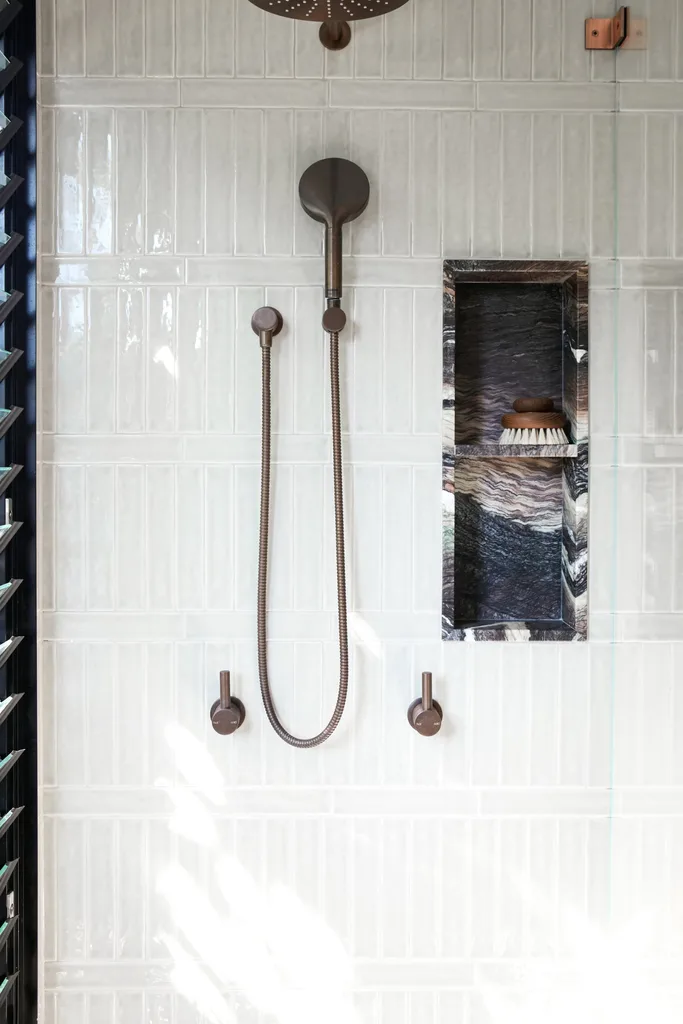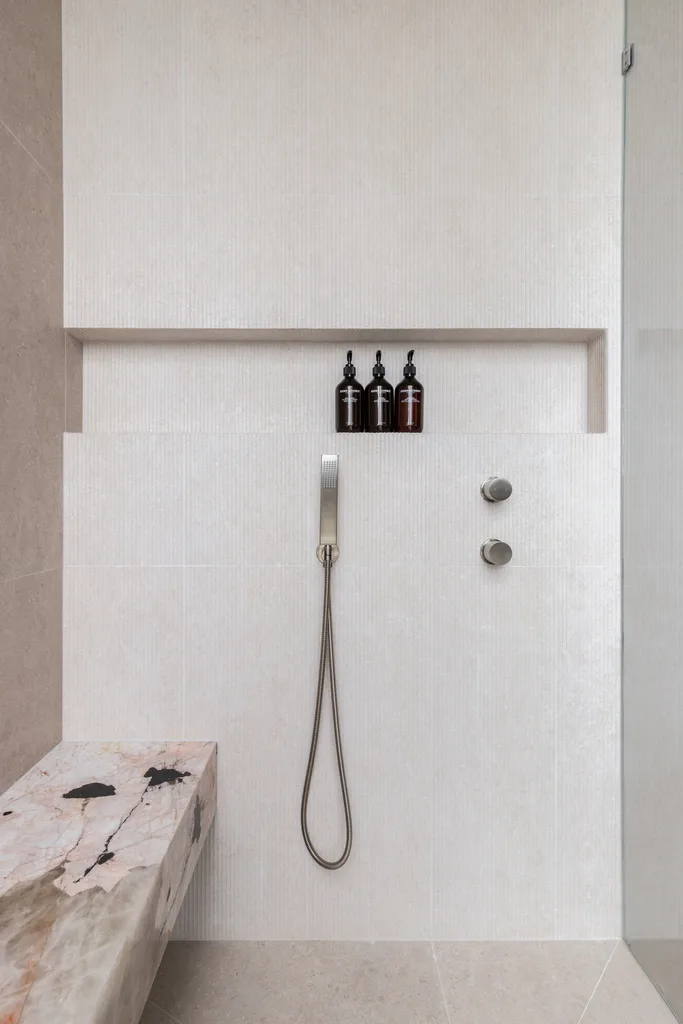Bathrooms, and showers in particular, are all about duality. They serve as retreats for relaxation, but are also highly functional spaces that are put through their daily paces. As such, storage is an essential part of bathroom design, not only for practicality but as a stylish feature.
Wall niches and ledges can have a dramatic impact, offering a neat cubbyhole to store shower products and serving as an artful shelf to showcase beautiful tiles and marble – the centrepiece of your wet zone. Better yet, a carefully placed bench works as both a rest area and convenient storage spot for lotions, potions and all your decorative bathroom pieces.
To help you decide whether a niche, ledge or bench suits the style and size of your bathroom, we asked the experts. From material choices to installation, get ready to say goodbye to your shower caddy for good…
Shower ledge
Sometimes less is more, which is precisely the view Monique Hemmingson took when designing the ledge in her own pared-back minimalist bathing space.

“For us, the shower ledge was a way to create a practical space that also limits clutter in the shower and bathroom,” she says.
Both niches and ledges can boast an almost seamless profile, especially when finished in matching tiles with mitred edges, trimmed at 45 degrees to meet at perfect right angles.
“Investing in a good tiler is key so you can have the edges mitred instead of capped, which can look busier,” explains Monique. “An adequate fall on your niche or ledge is also essential to avoid water pooling on its surface and prevent your tiles or stone from becoming mouldy or discoloured.”
“Aesthetically, a shower ledge provides both depth and interest.”
Katie Soineva, SMUB Studio
Shower niche

A contrasting shower niche makes a bold impression when set against a subdued backdrop, such as in the elegant bathroom designed by Parker Studio.
Paired with light tiles, the addition of dark marble has a luxurious appeal, and the tall, slender niche helps save space. “We were restricted in size, so we opted for a vertical niche, which draws the eye up and makes the most of the high ceilings,” says interior designer Caitlin Parker-Brown.
“When planned ahead of time, the framework inside the wall cavity can be adjusted to suit the exact niche location. Statement stone is a timeless option to make your niche, ledge or bench a standout, though finishes including microcement or tiles in contrasting designs work equally well.”
To determine the ideal dimensions of your niche, consider the size of your shower products. For placement, keep your niche away from the splash zone, on the opposite or adjacent wall, to safeguard against moisture build-up.
Shower bench

Designed with relaxation in mind, a shower bench is the perfect place to unwind, transforming any bathroom into a delightful day spa experience.
When designing the ensuite above, Todd Miller of Ziegler gave a floating bench seat pride of place and used a dramatic stone with earthy pinks that ties together the colours of the floor and wall tiles.
Tempted to add a bench to your bathing space? Take inspiration from the conveniently placed handheld shower in Brushed Nickel from ABI Interiors, which lets users take a seat while washing.
Above it, a linear niche runs perpendicular to the bench, creating a neat storage spot for toiletries. The neutral palette adds an elevated touch without overwhelming the eye for the ultimate bathroom bliss.
Experts’ best tips for designing a shower niche
For longevity, think about how your niche, ledge or bench seat will work with the style of your bathroom and home.
Sizing
“Typically, shower ledges are 1200 millimetres high from the tiled floor and 90 millimetres wide, to allow products to sit comfortably,” says Katie.
“Where possible, design the size of your niche around your tiles so you don’t have unnecessary or unsightly tile cuts,” suggests Caitlin.
Design
“Create a niche that’s less typical. Use materials that resonate with you and have personal meaning,” urges Tiffany Howell of Night Palm.
“If you have a few standout features, then you don’t need to overcomplicate things and can focus on the practicality of the layout and materials,” explains Holly Vaughan of Vaughan Design and Development.
Shape
“Your [builder] can frame out the niche to be any size or shape,” Tiffany explains. “Let your imagination go wild and have fun with shape.”
This article originally appeared on Home Beautiful and is republished here with permission.







